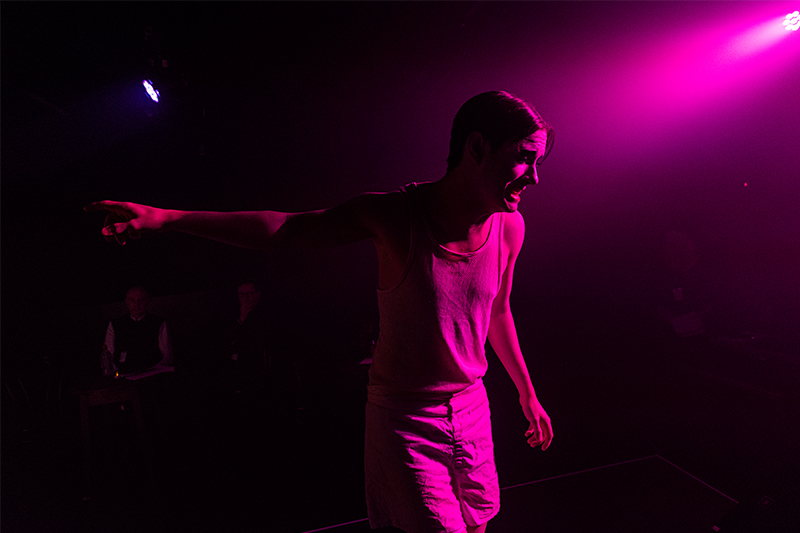NIDA’s directing, design, musical theatre, live production/technology and make-up students worked together to create an immersive, humorous, passionate, mischievous Weimar Era cabaret.

2019 Weimar Kabarett. Photography: Patrick Boland
One of the exciting aspects of the annual Weimar Kabarett is that it is the product of NIDA’s directing, design, musical theatre, live production and make-up students, working together in a great collaboration.

Hamish Pickering, 2019 Weimar Kabarett. Photography: Patrick Boland
This follows from one of NIDA’s advantages, which is that, with all different disciplines training and specialising under one roof, from acting to make-up to set construction, students are able to collaborate on large productions together in a way that replicates the reality of the TV, film and theatre industry.
2019’s Weimar Kabarett was curated by Head of Directing, Course Leader Dr Ben Schostakowski, and under the musical direction of award-winning composer, musical director and pianist Luke Byrne, who has been a tutor on NIDA’s Diploma of Musical Theatre for several years.

Tom Rodgers and Mel O’Brien, 2019 Weimar Kabarett. Photography: Patrick Boland
The program included songs by Brecht, Weill, Eisler, Spoliansky and Hollaender, but also songs made famous by Grace Jones, Judy Garland and Sam Smith.
‘Weimar cabaret acts as a historical and stylistic inspiration for the students – a musical form of decadence, fluidity and sharp political bite,’ said Dr Schostakowski.
The students used each of their specialist talents and training to bring to life an immersive, humorous, passionate and mischievous series of 12 Weimar Era cabaret pieces, all flowing together in one overarching nightclub narrative:

Make-up student Claudia Skelton and Musical Theatre student Sophie Gulloch, backstage at the 2019 Weimar Kabarett. Photography: Patrick Boland
The Master of Fine Arts (Directing) students created the vision for realising each different piece, working closely with the performers, the Diploma of Musical Theatre students.
The Bachelor of Fine Arts (Design for Performance) students worked closely with the directors, performers and make-up students to create the set and costume design for each piece, and set the tone for the make-up.

Mitchell France, 2019 Weimar Kabarett. Photography: Patrick Boland

Make-up student Monique Muskens and Musical Theatre student Krystal Meyer, backstage at the 2019 Weimar Kabarett. Photography: Patrick Boland
The Diploma of Screen and Media (Specialist Make-up Services) students brought the designers’ make-up ideas to life, developing each look and working closely with the performers.
Finally, the Diploma of Live Production and Technical Services students, whoshaped the technical requirements of the show, looked after lights, sound and stage management, working with everyone during the creation of each segment from rehearsal to the final performances.

Live Production and Technical Services students Nathan Bull, River Heart, Alexandra Moon and Harry Tanswell, backstage at the 2019 Weimar Kabarett. Photography: Patrick Boland
Dr Schostakowski explained, ‘The Weimar Kabarett project is a unique practical exercise for the directing students to experience working with a professional musical director on the development and direction of live musical acts.
‘One of the key aspects of working with a musical director is that the director has to express their vision for the staging of the material, and the musical director collaborates with them to help respond to that vision musically.
‘So essentially the process of directing is made more complex.
‘The cabaret context also suggests that the acts need to break down the ”fourth wall” in performance and interact in one way or another with the live audience in a close setting.’

Samuel Harmon, 2019 Weimar Kabarett. Photography: Patrick Boland
This interaction with the live audience was done by the 19 musical theatre students, who were the stars of the show. Behind the scenes, there were almost 50 more students involved
‘Even though we only see 20, there’s about 70 students involved because there’s eight directors, six designers, 20 performers, 15 live production and 14 make-up students,’ said Mark Gaal, Executive Director Pathways and Partnerships, who oversees the diploma courses at NIDA.
Seven and a half days of feverish rehearsal culminated in three performances (and one dress rehearsal) in a packed venue transformed into a Weimar Era nightclub.

Hamish Pickering and Jeremy Christie, 2019 Weimar Kabarett. Photography: Patrick Boland
Much of this atmosphere came from the work of the live production and technical students. Under the guidance of their tutors, the Diploma of Live Production and Technical Services students first had to make decisions about what sound and lighting equipment would be appropriate for the cabaret, which meant participating in rehearsals and being involved in the creation of each work with the directors and designers.
After deciding the equipment, the students then installed and rigged everything in the venue from scratch. Mark Gaal explained that, for sound, this meant installing ‘speakers, microphones, cables – everything that goes into making sound.
‘Then, having installed the equipment, they test it for purpose: they have people singing into the microphones, then they adjust the levels, decide which channels to use, which speakers they’ll come out of- it’s about installing and operating.’
‘They rig it themselves. Everything starts from scratch. Rigging means you have a choice of what lamps, and you hang them, then you focus them. The angle, the choice of lamp, where you put it, and how you install it…’ all have an artistic effect, Mr Gaal explained.
After making the technical decisions to support each artistic vision, the live production and technical students operated these systems seamlessly across 12 different pieces, each with a different mood, sound and lighting, for the performances of the 2019 Weimar Kabarett.

Mitchell France, 2019 Weimar Kabarett. Photography: Patrick Boland
Feeling inspired? Applications for NIDA in 2020 are open now. Visit apply.nida.edu.au
CUA51015 Diploma of Screen and Media (Specialist Make-up Services)
CUA50213 Diploma of Musical Theatre
